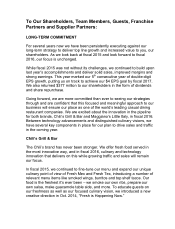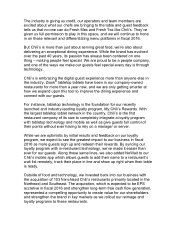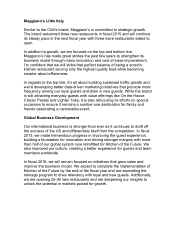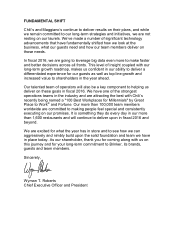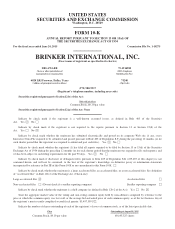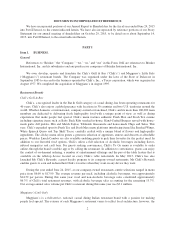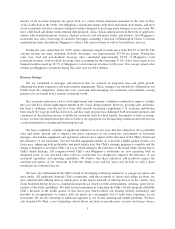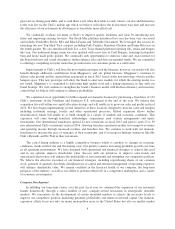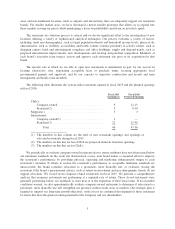Chili's 2015 Annual Report Download - page 13
Download and view the complete annual report
Please find page 13 of the 2015 Chili's annual report below. You can navigate through the pages in the report by either clicking on the pages listed below, or by using the keyword search tool below to find specific information within the annual report.During the year ended June 24, 2015, our domestic franchisees opened five Chili’s restaurants.
Following the end of our fiscal year 2015, we acquired Pepper Dining Holding Corp., a franchisee of 103
Chili’s restaurants primarily located in the Northeast and Southeast United States. This acquisition represented an
opportunity to create value for our shareholders and generate additional earnings and cash flow growth. We
continue to remain committed to growing and expanding our existing franchisees.
Restaurant Management
Our Chili’s and Maggiano’s brands have separate designated teams who support each brand including
operations, finance, franchise, marketing, peopleworks and culinary. We believe these strategic, brand-focused
teams foster the identities of the individual and uniquely positioned brands. To maximize efficiencies, brands
continue to utilize common and shared infrastructure, including, among other services, accounting, information
technology, purchasing, legal and restaurant development.
At the restaurant level, management structure varies by brand. A typical restaurant is led by a management
team including a general manager, two to six additional managers, and for Maggiano’s, an additional three to
four chefs. The level of restaurant supervision depends upon the operating complexity and sales volume of
individual locations.
We believe there is a high correlation between the quality of restaurant management and the long-term
success of a brand. In that regard, we encourage increased experience at all management positions through
various short and long-term incentive programs, which may include equity ownership. These programs, coupled
with a general management philosophy emphasizing quality of life, have enabled us to attract and retain key team
members, and enjoy turnover of managers and team members that is below industry averages.
We ensure consistent quality standards in all brands through the issuance of operations manuals covering all
elements of operations and food and beverage manuals, which provide guidance for preparation of brand-
formulated recipes. Routine visitation to the restaurants by all levels of supervision enforces strict adherence to
our overall brand standards and operating procedures. Each brand is responsible for maintaining their operational
training program. Depending on the brand, the training program typically includes a training period of two-to-
three months for restaurant management trainees, as well as special training for high-potential managers. We also
provide recurring management training for managers and supervisors to improve effectiveness or prepare them
for more responsibility.
Supply Chain
Our ability to maintain consistent quality and continuity of supply throughout each restaurant brand depends
upon acquiring products from reliable sources. Our pre-approved suppliers and our restaurants are required to
adhere to strict product and safety specifications established through our quality assurance and culinary
programs. These requirements ensure high quality products are served in each of our restaurants. We strategically
negotiate directly with major suppliers to obtain competitive prices. We also use purchase commitment contracts
when appropriate to stabilize the potentially volatile pricing associated with certain commodity items. All
essential products are available from pre-qualified distributors to be delivered to our restaurant brands.
Additionally, as a purchaser of a variety of protein products, we require our suppliers to adhere to humane
processing standards for their respective industries and encourage them to evaluate new technologies for food
safety and humane processing improvements. Due to the relatively rapid turnover of perishable food products,
inventories in the restaurants, which consists primarily of food, beverages and supplies, have a modest aggregate
dollar value in relation to revenues. Internationally, our franchisees and joint venture operations may encounter
cultural and regulatory differences resulting in variances with product specifications for international restaurant
locations.
7


